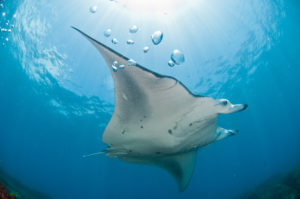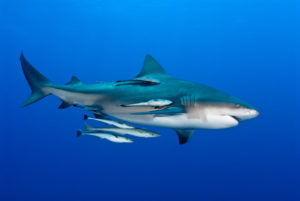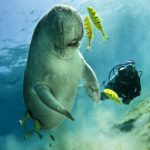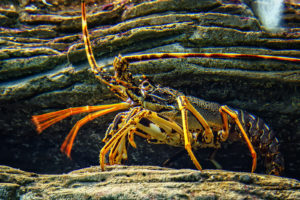Scuba diving in southern Mozambique is so fantastic that we’ve split our favorite options into two articles. See our first story here, which features more details on how to get to (and around) Mozambique, what to expect once you arrive, and when to go for the best diving. Here are our picks for our second set of southern Mozambique’s best dive sites.

Tofo and Barra
Where is it: Tofo and Barra are located about six miles (10 km) apart in the bay of Inhambane, located in Inhambane province, about 500 km (800 km) north of Maputo.
What makes it special: The area is probably one of Mozambique’s most famous dive destinations as travelers flock to enjoy the calm, clear waters and to see the mantas and whale sharks that usually migrate through the area. The bay of Inhambane, where Tofo and Barra are located, has calm waters with hardly any waves, offering a contrast to dive locations further south that feature rolling waves and (sometimes) tricky boat launches. The area has three manta-cleaning stations with lots of gullies, overhangs and ledges covered in hard and soft coral. Advanced divers can participate in deep drift dives along the walls and drop-offs. You are likely to see whale sharks, shoals of game fish, ghost pipefish, leaf fish, green turtles and a variety of sharks.
The main attractions in Tofo are mantas and whale sharks. You can see mantas throughout the year, and you’re most likely to spot whale sharks from October to April, although they are generally around most of the year. A trip to Barra lagoon, just off the beach in Barra, will delight you with its seahorse population. You might also see humpback whales between June and October.
Details: There are a number of flights from South Africa to Inhambane. You can travel from there via taxi to Tofo and Barra or arrange for an airport pick up. Travel time in a car from Maputo could take you about 8 to 10 hours with the last part of the way being on dirt road. There are a variety of accommodation options and dive operators to meet your needs.
When to go: Diving is good all year with water temperatures varying from 75 F (24 C) in the winter (June to August) to 84 F (29 C) in the summer (November to February). Reef depths vary from 59 to 130 feet (18 to 40 m. Visibility varies from 33 to 100 feet (10 to 30 m) and can change drastically from day to day.

Pomene and Morrungulo
Where is it: Pomene is located between Vilanculos and the town of Maxixe about 370 miles (600 km) north of Maputo. Morrungulu is about an hour and a half south of Pomene.
What makes it special: Manta encounters are likely on nearly every reef. There are many cleaning stations, caves and swim-throughs. You could also see sailfish, marlin and wahoo, as well as mobula and eagle rays. There are both a horse head, and a hand-shaped rock formation underwater and a cave with frequent bull-shark sightings. Interesting topography, such as fossilized stone gullies and occasional hammerhead sightings make dives on this continental shelf extra special.
Details: Pomene is about three hours from the nearest main road. You can drive to Pomene from Maputo or fly to Inhambane and then drive or take a taxi to your hotel. Driving from Maputo could take between 9 and 13 hours while driving from Inhambane will take from 4 to 6 hours. The dirt road between the main road and Pomene requires a four-wheel-drive vehicle and can be difficult to navigate. There are a few dive centers and accommodation options in Pomene and Morrungulo.
When to go: Diving is good all year with water temperatures varying from 75 F (24 C) in the winter to 84 F (29 C) in the summer. Reef depths vary from 30 to 105 feet (10 to 32 m), offering something for divers from all levels. Visibility varies from 30 to 100 feet (10 to 30 m).

Vilanculos Archipelago
Where is it: Vilanculos is a small coastal town about 435 miles (700 km) north of Maputo.
What makes it special: Here you could see dugongs as well as rays, turtles and game fish. There are humpback whales from June to October, whale sharks most of the year, and sharks ranging from silvertips to hammerheads. There are even Zambezi sharks in the area. Unique underwater topography means you’ll find sites where the coral looks like fairy castles and fossilized trees protruding from the ocean floor. Dive sites run the gamut from calm, shallow and relaxed for beginners to sites with strong currents where more-experienced divers can enjoy drift diving.
Details: You can either drive up or fly from Maputo to Vilanculos airport. The drive from Maputo to Vilanculos takes between 9 and 14 hours, while flights are about an hour and a half.
When to go: Diving is good all year with water temperatures varying from 75 F (24 C) in the winter to 84 F (29 C) in the summer. Reef depths vary from 20 to 144 feet (6 to 44 m), offering diving for divers from all levels. Visibility varies from 30 to 100 feet (10 to 30 m).

Bazaruto National Park
Where is it: Bazaruto National Park is a string of six islands nine miles (15 km) off the coast of Mozambique between Africa and Madagascar.
What makes it special: The sparsely populated Bazaruto Archipelago features one of the largest marine-conservation areas in the Indian Ocean, spanning 540 square miles (1400km²). The national park was created in 1971 to protect dugong and marine turtles and their habitats. You might also see a variety of dolphins and sharks, lots of healthy hard and soft coral and possibly humpback whales. There’s also an abundance of giant lobsters, green turtles, rays and game fish.
Details: You can take a boat from Vilanculos to the Bazaruto islands, and it’s best to discuss this option with your hotel. There are a few hotels and dive operators in the Bazaruto Archipelago and many dive operators from Vilanculos can assist with diving in Bazaruto.
When to go: Diving is good all year with water temperatures varying from 75 F (24 C) in the winter to 84 F (29 C) in the summer. Reef depths vary from 60 to 130 feet (18 to 40 m), offering something for divers from all levels. Visibility varies from 30 to 100 feet (10 to 30 m).
The post Best Scuba Diving in Southern Mozambique: Part II appeared first on Scuba Diver Life.
from Scuba Diver Life https://ift.tt/2smFWfn
No comments:
Post a Comment